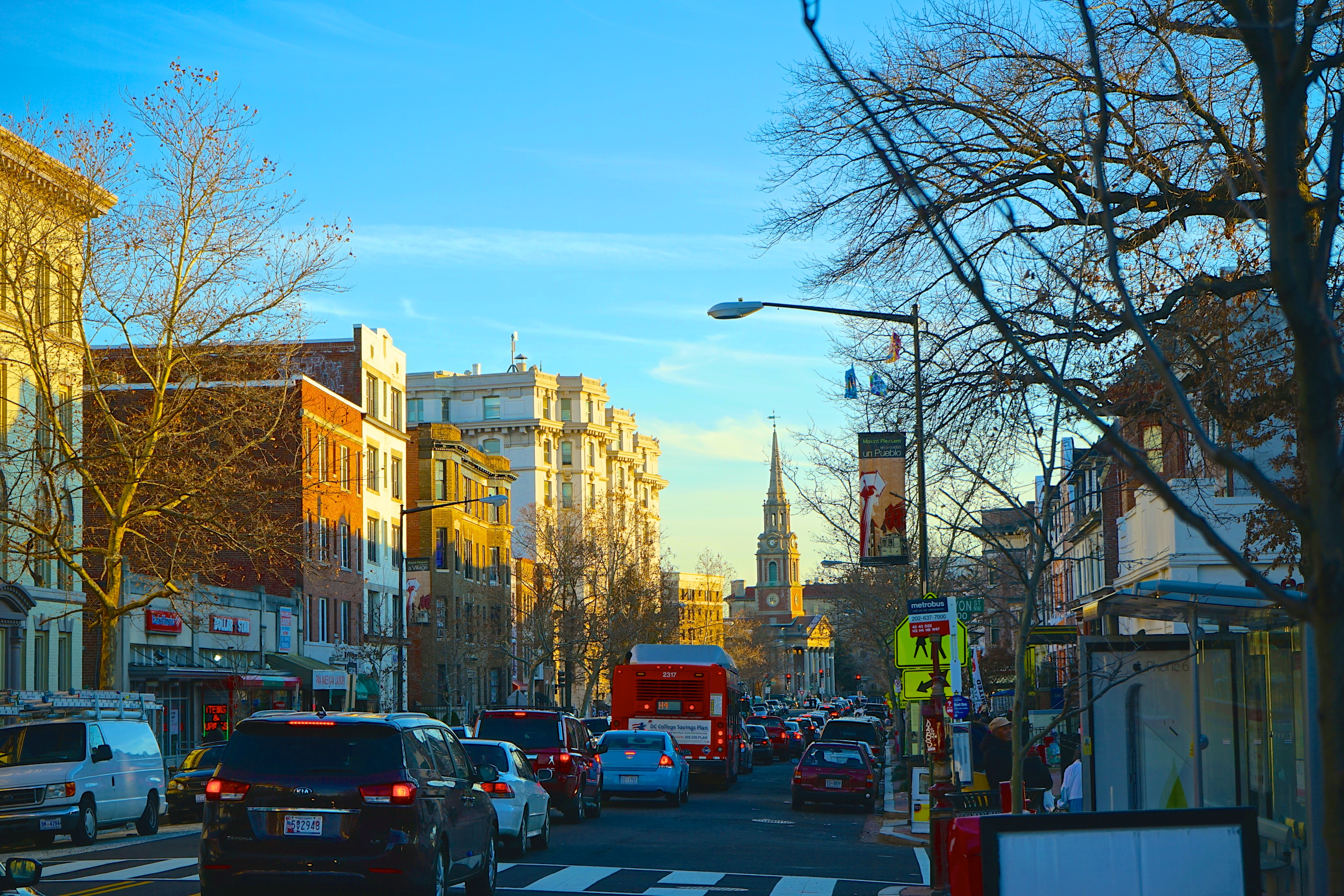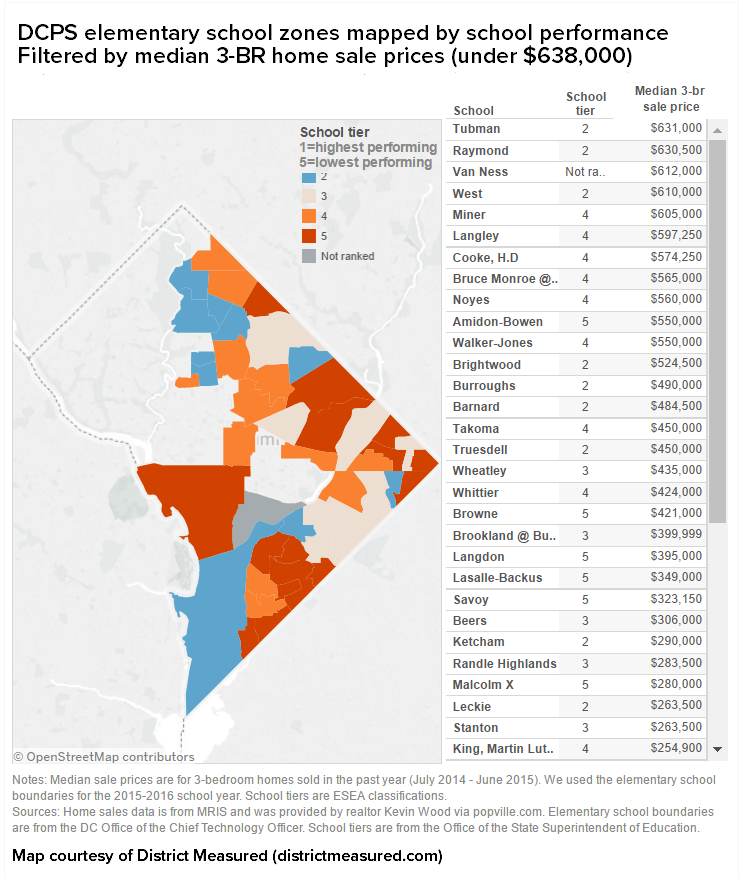This is the third part in a series. Read part 1 and part 2.
When considering houses for sale in Washington D.C.’s Ward 4, my wife and I see tree-lined streets, great parks, and neighborhoods still affordable for middle-income buyers.
Filling the District’s northern point, most of Ward 4 is wedged between Rock Creek Park, Petworth, Brookland, and Silver Spring, Maryland. But buying in Ward 4 isn’t just a $600,000 bet on a house; it’s a wager on education for our three small children.
A changing educational landscape
The District’s charter school movement has changed the odds when it comes to betting on public schools in D.C. Since the first D.C. charters opened in 1999, parents have increasingly factored these schools into their bets on neighborhoods. Students can attend the traditional schools assigned to their neighborhoods, or enter a District-wide lottery used to allocate out-of-zone spots. Most D.C. charter schools also participate in this district-wide lottery system.
Today, of the roughly 90,000 students attending public schools in D.C., about 46 percent attend charters, according to the D.C. Public Charter School Board. Without charter schools, it’s not clear where many of these students would attend school. Now, as we’re going through this process of researching schools, it’s not hard to imagine that without charters, many more families would have departed for the suburbs.
But getting spots in coveted schools – both traditional and charter – is not easy. Many of the best performing schools are already at capacity, and siblings of current out of zone students receive preference over new out-of-zone students. It’s common for families to either hold their pre-school age children back a year or try multiple years to get spots in a desired school.
Quality of schools
When researching the academic performance of schools near current Ward 4 listings, we understood why 51 percent of Ward 4 students attended school – both traditional public schools and charter schools – outside of Ward 4, according to a 2014 Urban Institute analysis.
What we’re experiencing now is in line with findings of a 2015 District Measured blog post: It’s expensive to live in a safe neighborhood served by top-scoring elementary schools.
We’re hoping to find a house for less than the $636,150 borrowing limit set for D.C. by the Federal Housing Administration and Department of Veterans Affairs. Sadly, underperforming schools are most likely serving neighborhoods with houses for sale in this price range. In fact, the District Measure post found that prospective home-buyers will only find a wide selection of affordable houses in this range in areas served by schools where only 45 to 60 percent of students are rated “proficient” or “advanced” in reading. Meanwhile, “in DCPS elementary school zones where 60 to 80 percent of students are proficient or advanced in reading, the median sale price of a three-bedroom home ranges from the high $600,000’s to over $1 million.” (The map below shows elementary school ratings in areas with median sale prices in our price range.)
Click to open an interactive map in a new window
With two exceptions, Niche.com rated Ward 4 schools as being not great to just bad. When evaluating schools, the Pittsburgh-based research firm considers academic data, performance on state proficiency tests, teacher salaries, absenteeism, diversity, and other factors. The D.C. Public School system (DCPS), including charters, ranked eighth out of 12 Washington-area school districts evaluated by Niche.com.
These types of rankings are not perfect and do not tell a particular school’s entire story. As David Albert has discussed in Greater Greater Washington, these rankings’ reliance on standardized testing is problematic, since it can only describe how students at those schools perform on those tests—not whether the school itself has improved a student’s performance. In other words, high-scoring students might have scored highly no matter where they went to school; all proficiency-based rankings can truly tell us is which schools the high-scoring students attend.
The problem, as Albert highlights, is parents don’t always have access to better data suggesting how well a school will help their children learn. In our case, starting our home search from the other side of the world, online rankings such as Niche.com provide the only realistic way for my wife and I to get a feel for schools and narrow down our housing search. (D.C. plans to unveil its own universal rating system based mostly on test scores, in order to give parents another tool to use when researching schools.) But we need to make a decision soon. Our first chance to visit schools will occur just weeks before the new school year starts—so we’re going to have to start our search with the tools we have.
And the tools we have paint a grim picture. For instance, one Ward 4 elementary school ranked by Niche reported 7 percent of students read at or above their grade level. This is a bitter pill to swallow. Our oldest child starts kindergarten in the fall. Like many families our housing search now focuses on school zones and which middle and high schools these elementary schools feed.
Quality of Life
Yes, most of Ward 4 is east of Rock Creek Park, a part of town many still consider being separated from great amenities, good schools, and safe neighborhoods. But this corner of the city has plenty to offer. The redevelopment plan for the former Walter Reed hospital site has the potential to bring new retail spaces and an estimated 4,000 new residents to the neighborhood. My sister lives in Petworth, and we have friends in this part of town. There’s a growing arts community nearby in Brookland, and attractions such as the Smithsonian, Verizon Center, and Nationals Park are still close. These are the reasons we want to live in the District.
For us, this corner of D.C. seems to offer the best chance of finding a home in our budget and still be near what we love about the city. So we study home listing photos emailed to us by our real estate agent and imagine where our family of five would be most comfortable. We ask where the boys and baby girl will sleep. We plot toy storage. We mentally place our T.V. and sofa in family rooms. We estimate work-commuting times. We count the blocks to the Takoma Recreation Center, a hidden gem with a long-course pool and well-maintained tennis courts.
Most of Ward 4 reports relatively low violent crime rates in such neighborhoods as Brightwood, Takoma, Lamond Riggs and Shepherd Park. For years now, Ward 4 has reported a diminishing number of violent crimes. Last year, the 478 reported violent crime incidents in Ward 4 represented just about 8 percent of the 5,728 total violent crimes committed in D.C., according to stats collected by the D.C. Metropolitan Police Department. In 2015, 600 violent crimes were reported in Ward 4, representing 9.6 percent of the total 6,246 violent crimes in D.C. that year.
What do families do?
We know several families who live in Ward 4. Many were attracted to relative safety in still affordable neighborhoods. All of these families either secured lottery spots in schools west of Rock Creek Park or transport their children to charter schools – often considered a lifeline for parents hoping to remain in the city but not at the expense of their children’s education.
It’s this lack of faith in the local public schools that apparently spawned a growth in Ward 4 charter schools. Yet the addition of new charters did little to stem the outflow of students. Despite increasing the number of Ward 4 charter schools from seven in 2006 to 18 in 2012, the Urban Institute study found during this time the percentage of Ward 4 student attending charters in Ward 4 decreased to 29 percent from 50 percent.
Part of this student exodus is likely caused by the existing school feeder patterns of Shepherd and Lafeyette Elementary Schools. These are the shining stars of Ward 4 schools. Both ranked among the District’s best by Niche.com. Students attending Lafeyette, in the heart of Chevy Chase, and Shepherd, located in D.C.’s northernmost neighborhood Shepherd Park, have already won the lottery – they’re assigned to attend Deal Middle School and Wilson High School in affluent Ward 3.
But Chevy Chase and Shepherd Park are pricey compared to other Ward 4 neighborhoods, and not as transit-friendly: The closest Metro stations – Friendship Heights, Silver Spring and Takoma – are still relatively far away.
Betting on building
There is some good news – the District’s political leaders understand a problem exists. They get it; there’s a brain drain of elementary school-age students leaving the system before middle school. For several years, and multiple mayoral administrations, city officials and citizen groups have debated plans to improve funding, facilities, and educational programs.
Most recently, the fiscal year 2017 D.C. school budget request of $610 million marked a 22 percent increase from 2012. Money is being spent on increasing the number of teachers in schools, re-envisioning how middle and high schools prepare students for the workforce, and increasing dual Spanish-English programs.
D.C. is also spending money on upgrading and renovating school facilities. DCPS is in the planning phase of adding a new middle school to the massive Coolidge High School renovation project in Ward 4. Construction is currently planned to begin this summer and finish in 2019. Designing the project is world-renown architecture firm HOK, known locally for creating the National Air and Space Museum and Orioles Park at Camden Yards. Basically, DCPS is betting if they build it, students will come.
Yet for us a lot of maybes remain. Will elementary school performance improve, and if so, will students from these schools remain in-zone to attend the new middle school? And even if academic performance improves at the elementary and middle school levels, will enough of these students remain in-zone to help lift up the academically struggling and under capacity Coolidge High?
So do we take the chance on spending a lot—more than we have, really—on a lot of maybes? The schools might improve, but if not, we’re faced with possibly securing lottery spots out of our school zones. Or maybe our children will be accepted into out-of-zone charter schools. Or maybe we spend the equivalent of a second mortgage on three children’s private school tuitions and fees for the next decade and a half. Or maybe, instead of spending $600,000 on a house and $600,000 or more on private school, we figure out a way to qualify for a $1.2 million mortgage and live in Cleveland Park.
My wife recently asked what are the benefits to living inside the District instead of Montgomery County. It’s a question worth considering. Maybe we shave a few minutes off our commutes by taking Metro from Takoma instead of Silver Spring, but increasingly, living in D.C. looks like a gamble with long odds and much more than money on the line. Maybe it’s time to consider homes in other municipalities?
This is the third part in a series chronicling the author’s family’s move back to D.C. Continue reading part 4: Perusing D.C.’s small stock of multi-bedroom rentals.

